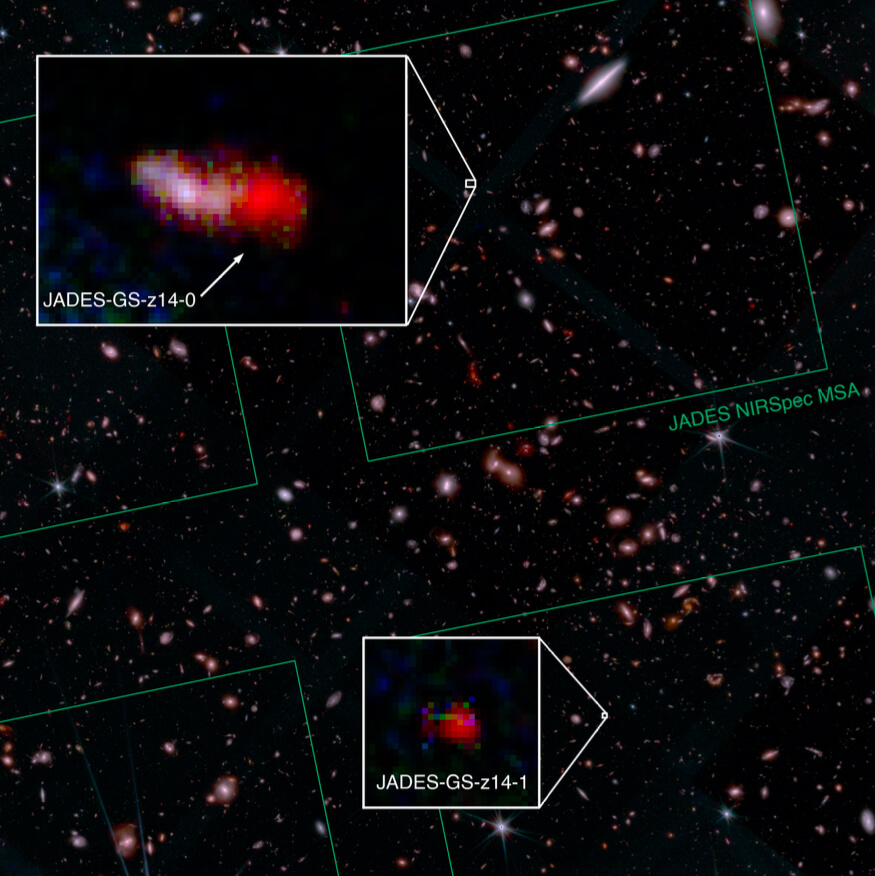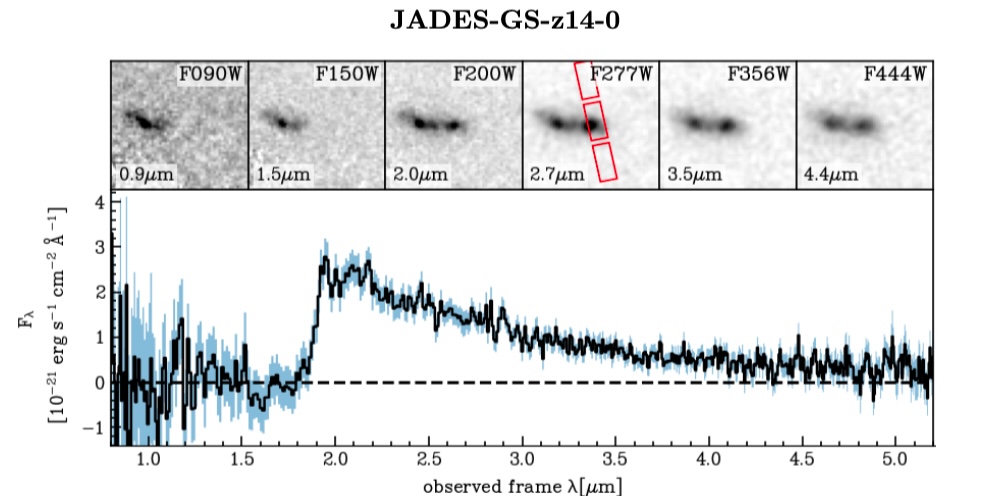James Webb discovers record-distant galaxy, again
Once again, the James Webb Space Telescope has expanded our cosmic frontiers: With the confirmation of two galaxies seen around 300 million years after the Big Bang, we are now closer than ever before to the epoch of the formation of the first galaxies. More than just another record, one of the galaxies is unexpectedly bright, compelling us again to reconsider our knowledge of how structure forms in the Universe.

Although the James Webb Space Telescope immediately after its "inauguration" in July 2022 broke the previous record for the most distant galaxy known, its hunt continues.
Not just to break a record, but — exploiting the fact that "distant" also means "looking far back in time" — to come as close as possible to the infancy of the Universe when the first galaxies were born.
And today, an international team of astronomers, including Peter Jakobsen from the Cosmic Dawn Center, announces the discovery of two record-breaking galaxies.
The galaxies have been found through the program "JWST Advanced Deep Extragalactic Survey" (JADES), and are accordingly dubbed JADES-GS-z14-0 and JADES-GS-z14-1. First identified in images, which provide a fast but approximate and uncertain idea about their distance, they have now been followed up with the more time-consuming, but also more unambiguous, technique spectroscopy.
This record beats the old one — also held by the JADES team — by 30 million years, bringing us a significant step further toward the very first galaxies, thought to be created 100–200 million years after the Big Bang.
Remarkably bright
In particular JADES-GS-z14-0, the most distant of the two, is remarkably bright, a signature of vigorous star formation. If this star formation has been going on for a while, the galaxy could already be rather massive, rekindling a previous discussion from Webb's first year:
According to our current understanding, structure built up in the early Universe by forming first small clumps of matter, slowly building up to larger structures. Meanwhile, our understanding from the local Universe of how much light stars emit may allow us to "translate" the galaxies' brightness to a total amount of stars.
This translation, however, is far from robust. But if JADES-GS-z14-0's exceptional brightness indeed translates into an exceptional amount of stars, either our understanding of structure formation or star formation, or both, is challenged.
While most astronomers are inclined to believe the latter, the former cannot be ruled out.
In principle the brightness may also be caused by so-called "active galactic nuclei", or AGN for short: a central, supermassive black hole into which gas is plummeting, shining brightly before disappearing forever. But in this case, the star-forming region is so extended — spread out over some 1700 lightyears — that the team argues that the galaxy is unlikely to host significant AGN activity.
Spectroscopy is key
The galaxies were first discovered using James Webb's camera NIRCam, and then confirmed by follow-up observations made with the telescope's spectrograph NIRSpec, which was developed under the scientific leadership of Peter Jakobsen.
“Our being able to look 30 million years further back in time compared to our previous record holder may not sound like much compared to the 13.5 billion years that it has taken the light from JADES GS-14-0 to reach us”, Peter Jakobsen says, “But the Universe was only 300 million years old when the light was emitted, so we are now able to explore times 10% closer to the Big Bang than before, which is significant."

The top panels show images of the galaxy JADES-GS-z14-0, taken through different infrared filters, from 0.9 µm to 4.4 µm. In each image, on the left is a foreground galaxy. But JADES-GS-z14-0, on the right in each image, is "invisible" through the 0.9 µm and 1.5 µm filter because its light is absorbed by surrounding gas.
This gives a hint of its distance, which the JADES team has now confirmed taking the spectrum seen in the bottom panel, dispersing the galaxy's light according to its wavelength. The exact wavelength at which light disappear tells us how far away it is. Credit: Carniani et al. (2024).
The discoveries are reported in three different articles, available at the preprint-server arXiv. One of these has just been accepted for publication in Astrophysical Journal.
Contact
Publications
- Carniani et al. (submitted): A shining cosmic dawn: spectroscopic confirmation of two luminous galaxies at z ~ 14, arxiv:2405.18485.
- Helton et al. (submitted): JWST/MIRI photometric detection at 7.7 μm of the stellar continuum and nebular emission in a galaxy at z > 14, arxiv:2405.18462
- Robertson et al. (accepted): Earliest Galaxies in the JADES Origins Field: Luminosity Function and Cosmic Star-Formation Rate Density 300 Myr after the Big Bang, arxiv:2312.10033
